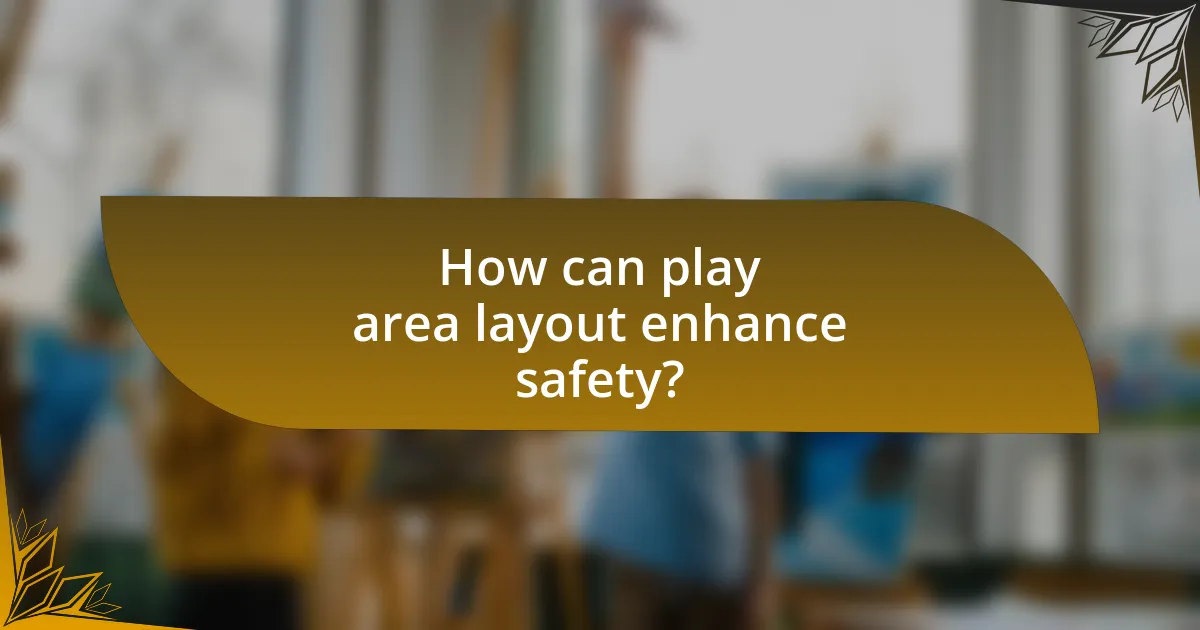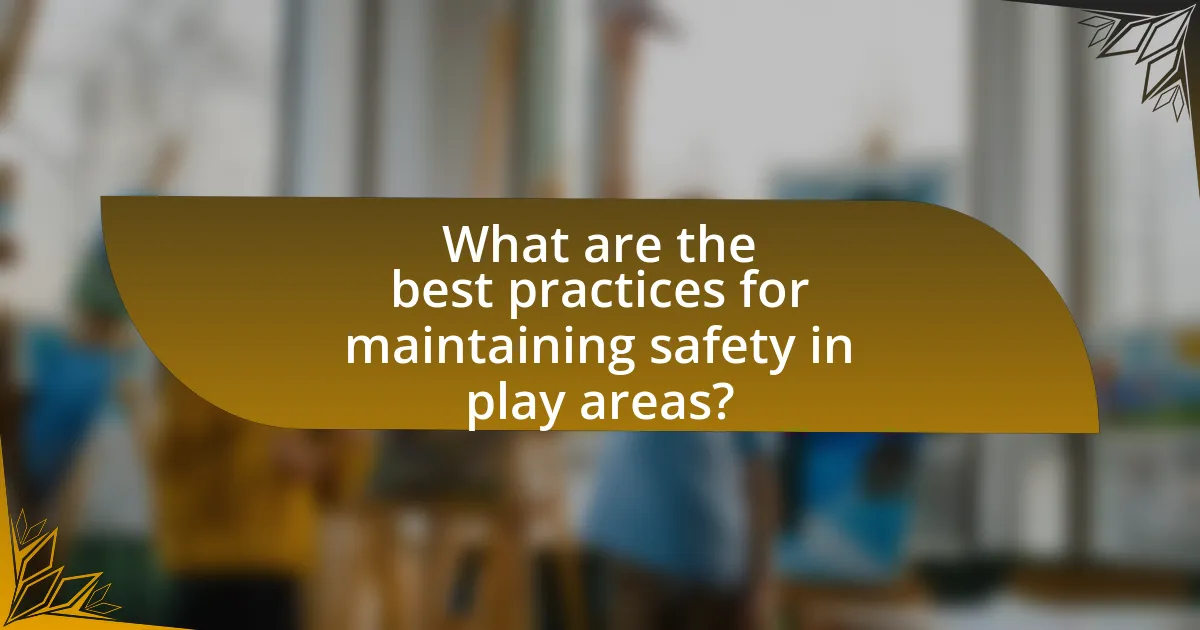The article focuses on the critical aspects of designing play areas with safety as a primary concern. It outlines key considerations such as the selection of non-toxic materials, proper equipment spacing, and the implementation of impact-absorbing safety surfacing to minimize injury risks. The influence of safety regulations, common safety standards, and the importance of risk assessments are discussed, emphasizing how these elements contribute to creating secure play environments. Additionally, the article highlights best practices for maintenance, community involvement, and educational resources for parents to ensure ongoing safety in play areas.

What are the key considerations in designing play areas with safety in mind?
Key considerations in designing play areas with safety in mind include selecting appropriate materials, ensuring proper equipment spacing, and implementing safety surfacing. Using materials that are non-toxic and durable minimizes injury risks; for instance, using wood or recycled plastic can prevent splinters and other hazards. Proper spacing between equipment allows for safe movement and reduces collision risks, with guidelines suggesting at least 6 feet between play structures. Additionally, safety surfacing, such as rubber mats or engineered wood fiber, absorbs impact and decreases the likelihood of injury from falls, with studies indicating that proper surfacing can reduce fall-related injuries by up to 80%.
How do safety regulations influence play area design?
Safety regulations significantly influence play area design by establishing standards that ensure the protection of children during play. These regulations dictate the materials used, the layout of equipment, and the overall safety features incorporated into the design. For instance, the Consumer Product Safety Commission (CPSC) provides guidelines that recommend specific fall heights and the use of impact-absorbing surfaces to minimize injury risks. Compliance with these regulations not only enhances safety but also promotes a more inclusive environment, as designs must accommodate children of varying abilities.
What are the most common safety standards for play areas?
The most common safety standards for play areas include ASTM F1487, which outlines safety requirements for playground equipment and surfacing, and the CPSC Handbook for Public Playground Safety, which provides guidelines for the design, installation, and maintenance of playgrounds. ASTM F1487 specifies criteria such as equipment height limits, spacing requirements, and impact attenuation for surfacing materials to minimize injury risks. The CPSC Handbook emphasizes the importance of proper supervision, maintenance, and age-appropriate equipment to ensure children’s safety while playing. These standards are widely recognized and adopted to promote safe play environments for children.
How can designers ensure compliance with safety regulations?
Designers can ensure compliance with safety regulations by thoroughly understanding and integrating relevant safety standards into their design processes. This involves familiarizing themselves with guidelines set by organizations such as the American Society for Testing and Materials (ASTM) and the Consumer Product Safety Commission (CPSC), which provide specific criteria for playground safety. By conducting regular safety audits and risk assessments during the design phase, designers can identify potential hazards and implement necessary modifications to meet safety requirements. Additionally, collaborating with safety experts and utilizing certified materials can further enhance compliance with established safety regulations.
Why is risk assessment important in play area design?
Risk assessment is crucial in play area design because it identifies potential hazards that could harm children. By systematically evaluating risks, designers can implement safety measures that minimize accidents and injuries. For instance, a study by the American Academy of Pediatrics highlights that well-designed play areas can reduce injury rates by up to 50% when risks are properly assessed and mitigated. This proactive approach ensures that play environments are not only enjoyable but also safe for children, fostering a secure space for physical activity and social interaction.
What factors should be evaluated during a risk assessment?
During a risk assessment for designing play areas with safety in mind, several key factors should be evaluated, including the physical environment, equipment safety, user demographics, and potential hazards. The physical environment encompasses the layout, surface materials, and proximity to hazards such as roads or water bodies. Equipment safety involves assessing the condition, age, and appropriateness of play structures for the intended age group. User demographics consider the age, abilities, and behaviors of children who will use the play area, ensuring inclusivity and accessibility. Potential hazards include identifying risks such as sharp edges, entrapment points, and inadequate fall zones. Evaluating these factors is essential to minimize risks and enhance safety in play areas, as supported by guidelines from organizations like the Consumer Product Safety Commission, which emphasizes the importance of comprehensive risk assessments in playground safety.
How can risk assessment improve play area safety?
Risk assessment can significantly improve play area safety by identifying potential hazards and implementing measures to mitigate them. By systematically evaluating the environment, equipment, and user behavior, risk assessments help in recognizing risks such as sharp edges, unstable surfaces, or inadequate supervision. For instance, a study by the American Academy of Pediatrics highlights that regular risk assessments can reduce injury rates in playgrounds by up to 50% when safety standards are adhered to. This proactive approach ensures that play areas are designed and maintained to minimize accidents, thereby enhancing overall safety for children.
What materials are best for safe play area construction?
The best materials for safe play area construction include rubber mulch, engineered wood fiber, and synthetic turf. Rubber mulch provides excellent shock absorption, reducing the risk of injury from falls, while engineered wood fiber is a natural option that meets safety standards for impact attenuation. Synthetic turf offers a durable, low-maintenance surface that is also designed to minimize injuries. According to the Consumer Product Safety Commission, using these materials can significantly enhance safety in playground environments by providing adequate cushioning and reducing hazards.
What are the advantages of using impact-absorbing surfaces?
Impact-absorbing surfaces significantly reduce the risk of injury during falls in play areas. These surfaces, such as rubber mats or engineered wood fiber, cushion impacts and lower the severity of injuries by dissipating energy upon contact. Studies indicate that using such materials can decrease the likelihood of serious injuries by up to 50%, making them essential for child safety in recreational environments. Additionally, impact-absorbing surfaces can enhance play area accessibility and comfort, encouraging more active participation while ensuring safety.
How do different materials affect safety and maintenance?
Different materials significantly impact safety and maintenance in play areas. For instance, soft materials like rubber and foam reduce the risk of injury during falls, while hard surfaces such as concrete increase the likelihood of serious injuries. Additionally, materials like wood require regular maintenance to prevent splinters and decay, whereas synthetic materials often need less upkeep and are more resistant to weather conditions. Research indicates that playgrounds with appropriate safety surfacing can reduce fall-related injuries by up to 80%, highlighting the importance of material choice in ensuring child safety.

How can play area layout enhance safety?
Play area layout can enhance safety by strategically organizing equipment and pathways to minimize hazards and ensure clear visibility. For instance, placing equipment with adequate spacing reduces the risk of collisions, while positioning benches and pathways away from active play zones prevents accidents. Research indicates that well-designed layouts can decrease injury rates by up to 30%, as evidenced by a study published in the Journal of Safety Research, which analyzed playground injuries and found that spatial organization significantly impacts safety outcomes.
What design strategies minimize hazards in play areas?
Design strategies that minimize hazards in play areas include using impact-absorbing surfaces, ensuring proper equipment spacing, and incorporating age-appropriate design features. Impact-absorbing surfaces, such as rubber mats or engineered wood fiber, reduce injury severity from falls, as studies show that falls are a leading cause of playground injuries. Proper spacing between equipment prevents overcrowding and allows for safe movement, while age-appropriate features ensure that children engage with equipment suited to their developmental stage, reducing the risk of accidents. These strategies collectively enhance safety and promote a secure play environment.
How does equipment spacing contribute to safety?
Equipment spacing contributes to safety by reducing the risk of collisions and falls among users. Adequate spacing between play equipment ensures that children have enough room to play without interfering with one another, which minimizes the likelihood of accidents. For instance, the U.S. Consumer Product Safety Commission recommends a minimum distance of 6 feet between play structures to prevent injuries caused by falls or impacts. This guideline is based on safety standards that aim to create a safer environment for children during play.
What role does visibility play in safe play area design?
Visibility is crucial in safe play area design as it enhances supervision and reduces the risk of accidents. When play areas are designed with clear sightlines, caregivers can easily monitor children, allowing for prompt intervention in case of unsafe behavior or emergencies. Research indicates that environments with high visibility significantly decrease the likelihood of injuries; for instance, a study published in the Journal of Environmental Psychology found that well-lit and open play spaces led to a 30% reduction in accidents. Therefore, incorporating visibility into play area design not only promotes safety but also fosters a sense of security for both children and caregivers.
How can natural elements be integrated safely into play areas?
Natural elements can be integrated safely into play areas by selecting non-toxic materials, ensuring proper maintenance, and designing with safety features. For instance, using natural wood for structures can provide a safe play environment when treated with child-safe finishes to prevent splinters and decay. Additionally, incorporating soft landscaping, such as grass or mulch, can cushion falls and reduce injury risk. Regular inspections and maintenance of these elements are crucial to ensure they remain safe and functional. Research indicates that natural play environments can enhance children’s physical and cognitive development while maintaining safety standards, as highlighted in studies by the University of Illinois, which found that children engage more creatively in natural settings.
What are the benefits of using natural play features?
Natural play features enhance children’s physical, cognitive, and social development. These features, such as logs, boulders, and water elements, encourage active play, which improves motor skills and coordination. Research indicates that children who engage with natural play environments exhibit increased creativity and problem-solving abilities, as they navigate diverse terrains and challenges. Additionally, natural play areas promote social interaction, as children collaborate and negotiate during play, fostering teamwork and communication skills. Studies show that children are more likely to engage in physical activity in natural settings, contributing to better overall health and well-being.
How can natural elements be made safe for children?
Natural elements can be made safe for children by ensuring they are free from harmful substances and hazards. This involves selecting non-toxic materials, such as untreated wood and natural stones, and regularly inspecting these elements for sharp edges, splinters, or decay. Additionally, implementing safety measures like soft ground coverings, such as mulch or grass, can reduce injury risks from falls. Research indicates that natural play environments, when designed with safety protocols, can enhance children’s physical and emotional well-being while minimizing risks (Fjortoft, 2004, “The Natural Environment as a Playground for Children: The Impact of Outdoor Play Activities in Pre-Primary School Children”).

What are the best practices for maintaining safety in play areas?
The best practices for maintaining safety in play areas include regular inspections, proper surfacing, and adherence to safety standards. Regular inspections ensure that equipment is in good condition and free from hazards, while proper surfacing, such as using impact-absorbing materials like rubber mulch or engineered wood fiber, reduces the risk of injuries from falls. Adhering to safety standards set by organizations like the Consumer Product Safety Commission (CPSC) and the American Society for Testing and Materials (ASTM) provides guidelines for equipment design and installation, further enhancing safety. These practices collectively contribute to a safer play environment for children.
How often should play areas be inspected for safety?
Play areas should be inspected for safety at least once a month. Regular inspections help identify hazards such as wear and tear, structural issues, or unsafe equipment. According to the U.S. Consumer Product Safety Commission, frequent inspections are essential to maintain safety standards and ensure that play areas remain safe for children.
What key elements should be included in a safety inspection checklist?
A safety inspection checklist should include key elements such as hazard identification, equipment condition, surface safety, accessibility, and emergency procedures. Hazard identification involves assessing potential risks like sharp edges or unstable structures. Equipment condition checks ensure that play structures are intact and free from defects, while surface safety evaluates the adequacy of materials like mulch or rubber mats to cushion falls. Accessibility ensures that play areas are usable for children of all abilities, and emergency procedures outline steps for responding to accidents or injuries. These elements are essential for maintaining a safe play environment and are supported by safety standards from organizations like the Consumer Product Safety Commission, which emphasizes the importance of regular inspections to prevent injuries.
How can maintenance schedules be effectively managed?
Effective management of maintenance schedules can be achieved through the implementation of a systematic approach that includes regular assessments, prioritization of tasks, and the use of technology for tracking. Regular assessments ensure that all play area equipment is inspected for safety and functionality, allowing for timely identification of issues. Prioritization of tasks based on urgency and impact on safety helps allocate resources efficiently. Utilizing technology, such as maintenance management software, enables real-time tracking of maintenance activities, scheduling, and documentation, which enhances accountability and ensures compliance with safety standards. This structured method is supported by studies indicating that organized maintenance practices significantly reduce accidents and improve overall safety in play areas.
What role do community and parental involvement play in safety?
Community and parental involvement significantly enhances safety in play areas by fostering a collaborative environment that prioritizes children’s well-being. When parents and community members actively participate in the design and maintenance of play spaces, they contribute valuable insights regarding safety concerns and preferences. Research indicates that neighborhoods with engaged parents and community organizations report lower incidents of accidents and injuries in play areas, as these stakeholders are more likely to advocate for safety measures such as proper equipment, regular inspections, and community awareness programs. For instance, a study published in the “Journal of Environmental Psychology” found that community-led initiatives in urban parks led to a 30% reduction in playground injuries, demonstrating the effectiveness of collective involvement in promoting safety.
How can community feedback improve play area safety?
Community feedback can significantly improve play area safety by identifying specific hazards and suggesting enhancements based on user experiences. Engaging local residents allows for the collection of diverse perspectives, which can highlight overlooked safety issues, such as inadequate surfacing or faulty equipment. For instance, a study by the American Academy of Pediatrics found that community involvement in playground design led to a 30% reduction in reported injuries. This data underscores the importance of incorporating feedback to create safer environments for children.
What educational resources can be provided to parents about play area safety?
Educational resources that can be provided to parents about play area safety include guidelines from the Consumer Product Safety Commission (CPSC), which offers a comprehensive handbook on playground safety. This handbook outlines safety standards, maintenance tips, and hazard identification to ensure safe play environments. Additionally, the National Program for Playground Safety (NPPS) provides online training modules and resources that educate parents on safe play area design and supervision practices. These resources are essential as they are based on established safety protocols and research, ensuring that parents are well-informed about potential risks and safety measures in play areas.
What are practical tips for ensuring ongoing safety in play areas?
To ensure ongoing safety in play areas, regularly inspect equipment for wear and tear, ensuring all components are secure and free from hazards. Regular maintenance checks can identify issues such as rust, loose bolts, or damaged surfaces, which can lead to accidents. Additionally, implementing safety guidelines, such as age-appropriate equipment usage and clear signage, helps educate caregivers and children about safe play practices. Research indicates that well-maintained play areas reduce injury rates significantly, highlighting the importance of consistent oversight and adherence to safety standards.
